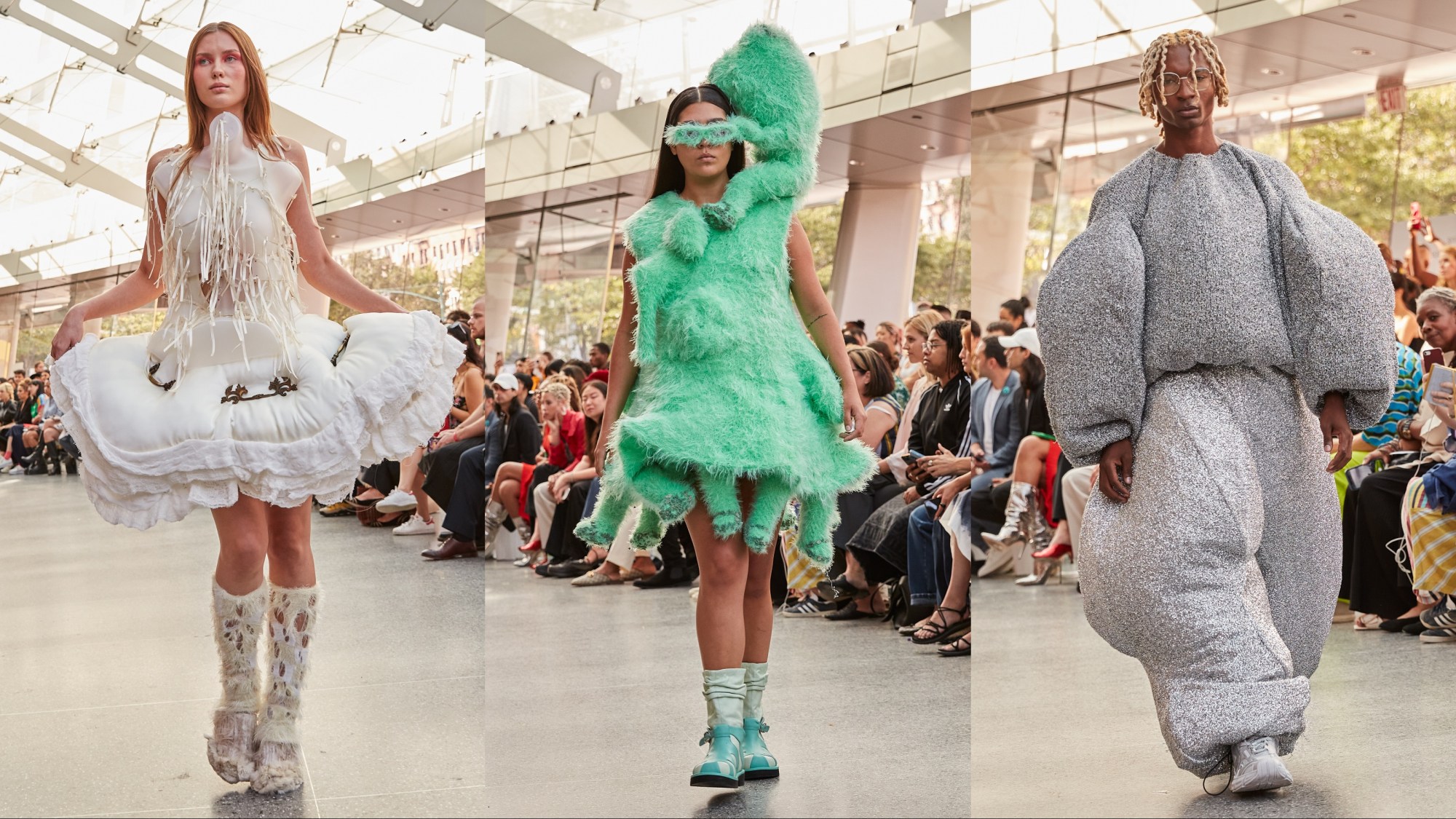No matter how busy New York Fashion Week might be, an off-schedule highlight is always the Parsons MFA Fashion Design and Society graduate show. This year’s activation was no different, entitled “WE DEM KIDS,” which saw the class of 2023 reflect on the beauty of shared experiences, the resilience of heritage and those unshakable bonds that tie us to the past and propel us into the future.
Though the show took place in the airy halls of the Brooklyn Museum, inspiration was found around the globe: Siri explores varying forms of sexual expression in her places of upbringing — Thailand and Germany; Ying Kong confronts China’s 996 work culture; Yamil Arbaje considers Latin American youth, and their place in today’s world; and Nan Jiang finds home “not in a physical place, but a psychological realm”. Though these are just a few honorable mentions!
Read on to meet this year’s top grads, who discuss their inspirations, the challenges they faced in creating their Parsons MFA collections and the future of fashion, and explore some of the standout collections below.

Sunny Ning
What story, idea or concept was central to this collection?
The collection’s name comes from a Chinese poem, “犹抱琵琶半遮面”
“She came, her face half hid behind a pipa still.” The collection is about identifying my understanding of femininity. My definition of femininity is influenced and reflected by both my mom and my generation; my understanding of sexy is rooted in Chinese traditional thinking. It’s not showing off your body with revealing clothing, but rather about elegance and subtlety. You can see the outline of the body without revealing too much skin.
What was the most challenging part of creating it?
The most challenging part of this collection is definitely the handcraftsmanship. All the pieces are hand knitted on a Dubied knitting machine, done by me. Since all my looks are made with complicated techniques, it’s impossible for me to make toiles before the final looks. Sometimes even though you made accurate calculations and measurements for the knit pieces, when you finish knitting and pull it off the machine, it can be a lot different from what you planned.
What is your first-ever fashion-related memory?
The first year I went to London to study, for my bachelor’s degree. I was helping my friend for his BA runway show in CSM, and that was the first time I participated in the whole process of producing garments, casting models and all the preparation for a runway show. That experience left a huge impression on me. After all the hard work, you got to see the pieces you worked on being shown under the spotlight.
What encourages you to keep going, especially in a fashion world that needs solutions?
As a knitwear designer and from my perspective, I wouldn’t say knitwear is craftsmanship, I would say it’s a form of art. Knitting is the thing that always encourages me to keep going. My goal is changing people’s stereotype with it — knitwear is not only chunky and handcrafted, it can be stunning and delicate.
Where do you see yourself as a designer in the next five years?
I’m going to have my own knitwear brand.
What modern designers inspire you today?
John Galliano.
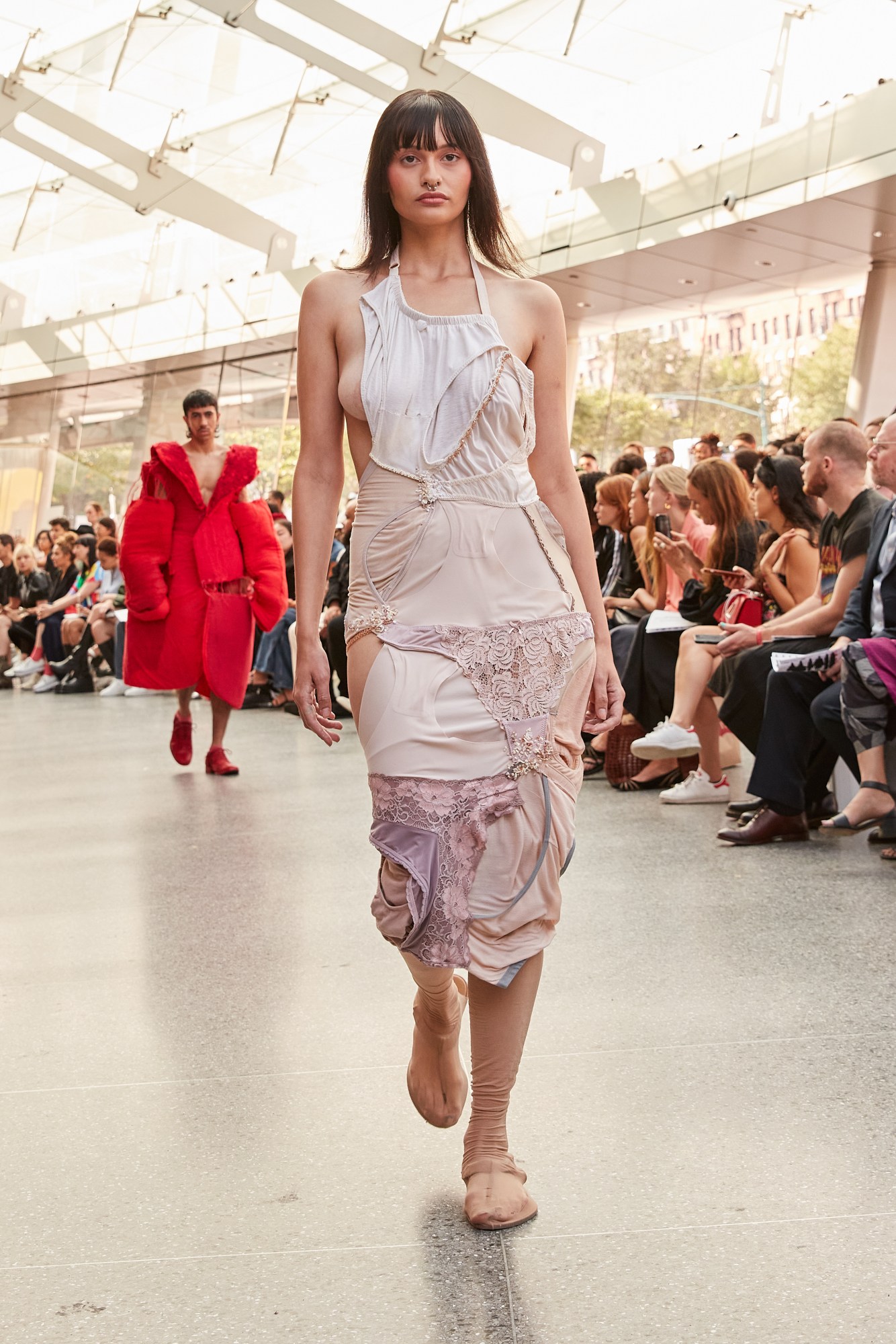
Siri
Where do you look for inspiration?
I find my inspiration in anime and cartoons. I often incorporate these elements into my work, as they inspire me through their unique silhouettes, fantastical elements and the sense of playfulness and ease they bring to their narratives.
What story, idea or concept was central to this collection?The ‘2001’ collection aims to foster open conversations about sexual expression and promote sex education through its designs. It holds personal meaning for me, as it represents the year I moved from Thailand to Germany, exposing me to a vastly different perspective on sexuality and nudity. Emerging from a culture where women are often expected to remain silent, my designs serve as a means of bringing the internal, the emotional and the taboo to the forefront. To create a circular textile chain, I developed a technique that converts old garments into fabric yardage once more. This innovative process involves the transformation of used underwear and tights into avant-garde monochromatic looks, with the intention of normalizing our relationship with our bodily fluids.
What do you hope to communicate to your audience with it?
My collection acknowledges the complexities of growing up in a world saturated with conflicting messages about sexuality and body image. By repurposing everyday garments like underwear and tights, I challenge conventions and encourage a sense of creativity and rebellion. I hope to empower young individuals to openly address these societal challenges, promoting a more inclusive and educated approach to sexual expression, and I hope that my collection sends a message that fashion can be both expressive and responsible.
What encourages you to keep going, especially in a fashion world that needs solutions?
I’m very passionate about finding sustainable and circular solutions in the textile industry. I’m certain that as designers, we hold a tremendous influence — not only in shaping how our audience consumes fashion but also in redefining the profound relationship we share with our garments.
Where do you see yourself as a designer in the next five years?
In the coming years, I plan to gain valuable experience by working with a fashion brand, concentrating on embroidery and couture techniques to further refine my craft. Simultaneously, I plan to develop methods for practicing fashion design with a conscious and sustainable approach.
What modern designers inspire you today?
Rei Kawakubo.
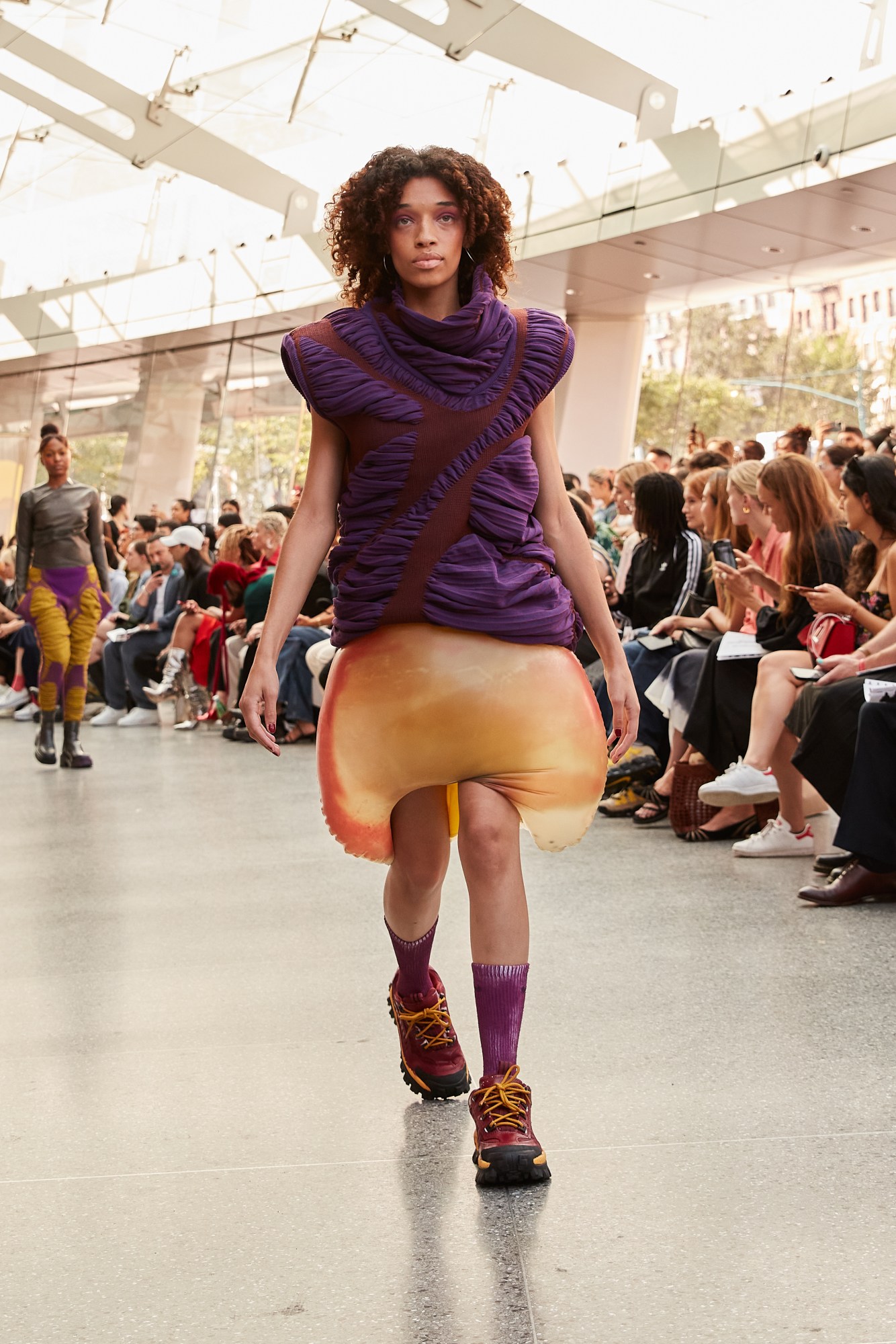
Hsiao Han Kuo
Where do you look for inspiration?
I like walking around the city with no destination, inspiration just comes naturally.
What story, idea or concept was central to this collection?
In this collection, I used eaten apples to express the feeling of being gradually consumed by a kind of emotion, and the feeling of wanting to disappear in this world. It’s a very sad feeling, but I want to express this emotion in a visually funny and playful way, without bringing a negative energy to my audience. The message is to bring connection, joy and healing to individuals who’ve experienced trauma or simply, had difficult days.
What was the most challenging part of creating it?
When I started to develop the concept of this collection, for me, it was a very dark time in my life. I let myself sink into sadness and isolated myself from my classmates, friends and families. Deep in my heart, I wanted someone to save me from this negative energy, but I knew that no one could save me except myself. So, I started trying to go to school more often, trying to show up even though I didn’t want to. And everything became better since I started to reconnect with the people around me. This experience gave me the passion to create because I knew I wasn’t the only person in this world who experienced this kind of emotion.
What is your first-ever fashion-related memory?
I grew up in a knitwear factory. People who work in the factory usually don’t associate with the word “fashion.” But they are the most important people who bring everything to life. Despite having allergic rhinitis, I grew up hiding and playing in the sample room.
Where do you see yourself as a designer in the next five years?
I want to work for other brands for around two years, then I want to go back to Taiwan and work with my father, starting my own brand and knitting center in a place near the sea and mountains.
What modern designers inspire you today?
JW Anderson.
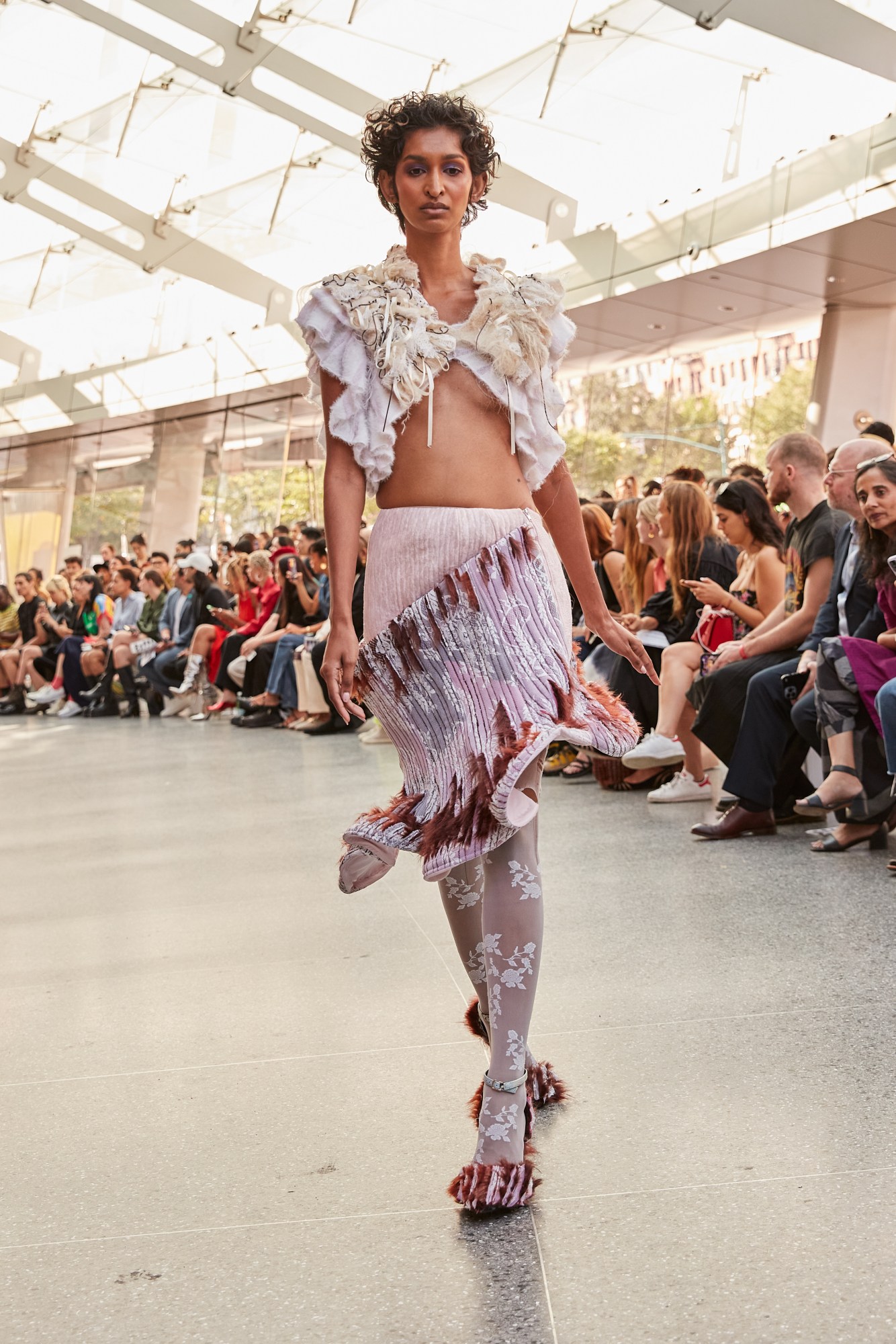
Nan Jiang
What story, idea or concept was central to this collection?
My collection, titled ‘“Home” decor, in decay’ delves into themes of alienation and self-revelation. I’ve often felt dissociated in my life, a sensation shared by many who conceal their true selves behind masks. Through my work, I aim to uncover the world’s scars, vulnerabilities and chaos hidden beneath appearances, questioning the need for pretense and the pursuit of perfection. I seek a path to genuine vitality, a “home” not in a physical place, but a psychological realm — a gateway to which could be found in objects like childhood mementos or even death itself. I want my audience to share in this safe space, free from judgment or ridicule, as we express ourselves openly.
What do you hope to communicate to your audience with it?
I aim to convey a celebration of the healing process and the inherent beauty that arises from life’s challenges. I want to emphasize that while scars may symbolize our past wounds, they also serve as a testament to our resilience and inner strength.
What is your first-ever fashion-related memory?
I had a lot of Barbies when I was a kid, but I didn’t like most of their princess dresses. I didn’t know how to sew, so I used scissors to cut down their gowns and turned them into distressed bikinis and mini skirts.
What encourages you to keep going, especially in a fashion world that needs solutions?
Fashion as a form of self-expression. However, I desire to see a more equitable fashion world, one that doesn’t tolerate underpayment and offers respect to everyone involved in the industry.
Where do you see yourself as a designer in the next five years?
I see myself as a designer who pushes the boundaries of conventional fashion, perpetually exploring unconventional art formats, including video art and installations. My goal is to bridge the gap between artistic vision and tangible reality, all while embracing adventure and authenticity.
What modern designers inspire you today?
Vivienne Westwood.
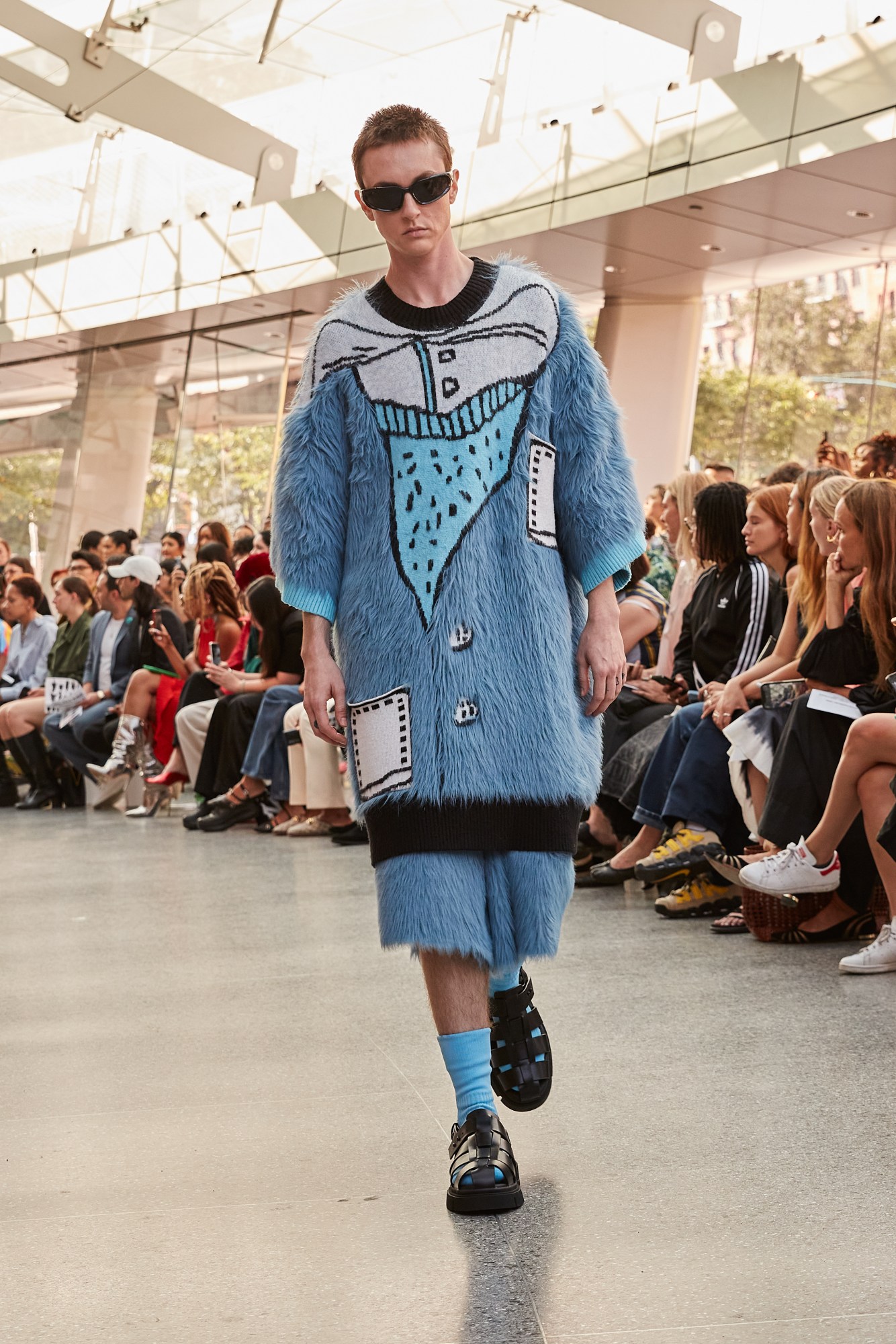
Yu Gong
Where do you look for inspiration?
Artists, museums, movies and everyday life.
What story, idea or concept was central to this collection?
The gap between digital and physical fashion, offering unique digital experiences for collection and exchange. This project centers on a tech-savvy community that translates daily archetypes from digital to physical, forging connections that bridge their identities across both realms.
What do you hope to communicate to your audience with it?
I want to use fashion as a medium to build a bridge try to bridge the gap between the physical and digital worlds. Through the whole design process, there is organic interaction between traditional garment construction methods and digital software.
Where do you see yourself as a designer in the next five years?
Graduating Parsons helps me to build my own world, identity and aesthetic, but it is also a new beginning. I’m open to different forms of art and looking forward to collaborating with different talents.
What modern designers inspire you today?
Virgil Abloh. Demna. JW Anderson.

Ying Kong
Where do you look for inspiration?
Before starting a new collection, I usually do a self-interview, gathering my latest observations and feelings. I use everyday experiences as sources of inspiration, integrating the reflections of people’s inner selves into designs.
What story, idea, or concept was central to this collection?
The pervasive China 996 work culture has exacerbated emotional depletion and body overdraft. The collection is built around the concept of geometric tailoring and movable construction that conform to the 360-degree curvature of the human body and plays with archetypes of formal wear, juxtaposing with details of outdoors and casual attire. To elevate the functionality of the garments, each piece needs engineered details. That includes a high level of tension with elastics, bungee cords and special knits that achieve an effect between the controllable and uncontrollable. Tension is used as a conceptual element to reflect on the relationships between work and life, the wearer, and the forms they use. Each look reflects on these relationships and reveals the tactics to revolutionize the stereotypes and rules in a playful and humorous way.
What was the most challenging part of creating it?
Continuously challenging my weaknesses and turning them into strengths during this process has been both a moment of self-doubt and self-affirmation for me. Creating the entire collection led me to transition from being a design student to being a designer, with a greater focus on achieving ‘profound in easy language’ in my work.
Where do you see yourself as a designer in the next five years?
Over the next five years, my brand will evolve as a platform for engaging in meaningful dialogues about prevalent social issues with each collection. The strategic focus will be on securing funding and venturing into brick-and-mortar retail, enhancing accessibility. Design endeavors will be centered around elevating customer experiences, fostering cultural inclusivity, and fostering enriching collaborations with artists and professionals across diverse industries.
What modern designers inspire you today?
Aitor Throup. Martine Rose. Glenn Martens.
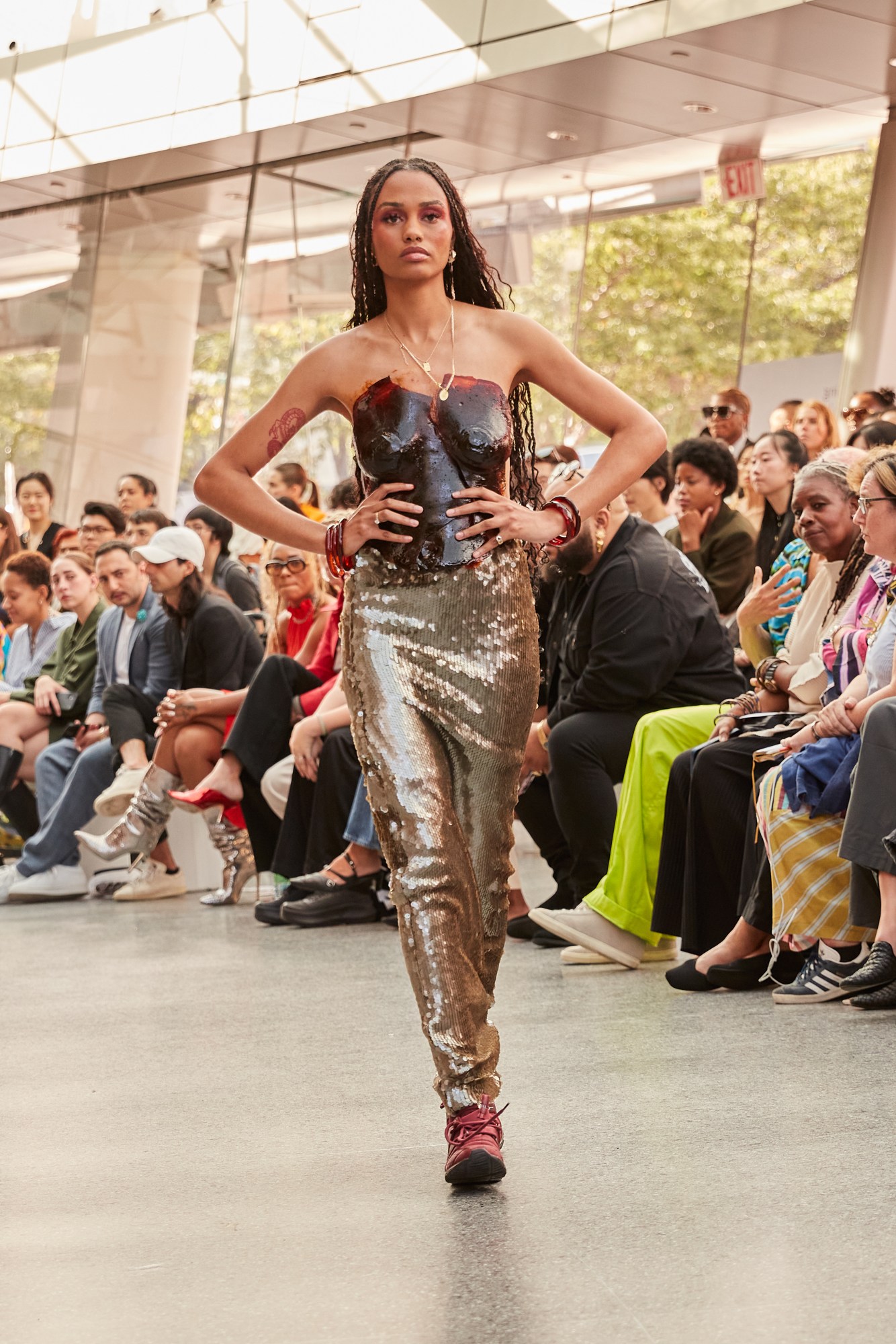
Mel Corchado
Where do you look for inspiration?
I look for inspiration by exploring solutions to the fashion industry’s most urgent issues — like the exploitation of land and labor, overproduction and overconsumption. But inspiration consistently finds me within my own community. I come from an incredibly rich New York-based Latine culture, and regardless of their ethnic or national identity, my friends and family are extremely creative, intuitive and resilient. There is no one I’d rather design with and for than my people.
What story, idea, or concept was central to this collection?
Community, co-creation, and connection! The entire premise of the project was about centering processes of collaboration and care in an industry that consistently prioritizes profit over people. I brought seven femmes (of color), whom I love dearly, into a co-creation process with me. I asked them to exercise their aesthetic agency, and throughout the process, we strengthened our interpersonal relationships with one another.
What is your first-ever fashion-related memory?
My mom says that I was an absolute nightmare in the mornings when I was young. She used to joke that she would always have a new outfit stashed in the back of the closet in case of an emergency because nothing turned my mood around like a fresh new fit.
What encourages you to keep going, especially in a fashion world that needs solutions?
The pure potential of an alternative, more creative, more just and more connected fashion ecosystem.
Where do you see yourself as a designer in the next five years?
I hope to build a tight-knit community around my label that consistently engages with both the fire-ass-made-to-last clothes and our educational and political programming around consumption, production, worker rights, and circular economies.
What modern designers inspire you today?
I love what the Slow Factory is doing around political education and fashion. BlueTin Production, a garment worker cooperative and manufacturer in Chicago that identifies as an abolitionist organization. Also Garment Worker Center in LA.
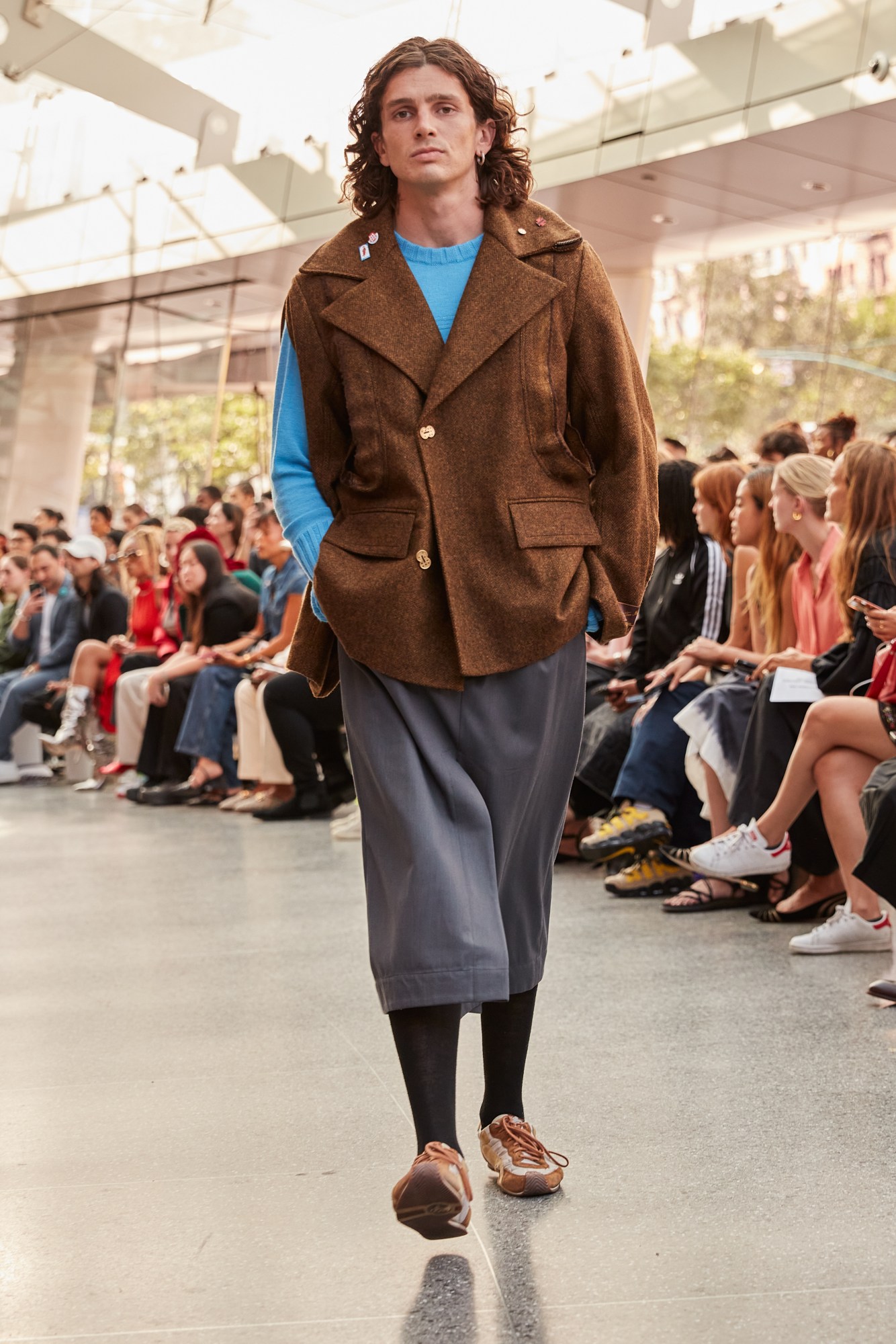
Yamil Arbaje
What story, idea or concept was central to this collection?
To rethink the Latin American youth and their position in today’s world. For this, I researched and traced the life of a Dominican fictional artist, Leandro Cid. I took his life as an example of what the youth should be; each look represents a stage in his life.
What is your first-ever fashion-related memory?
When I was 10, I came to the US and I suddenly wanted the ugliest DC shoes in the market. When I came back to school in Santo Domingo, everybody was laughing about them.
What encourages you to keep going, especially in a fashion world that needs solutions?
I just really like clothes. They way they are made, what they communicate, the colors, etc. How nice it is to just do beautiful clothes and wear them… on top of that, you can tell your own story, you can have your own business rules and you can represent people, engage with your community. You can’t do that by having a construction company…
Where do you see yourself as a designer in the next five years?
Working with brands I admire and developing my own brand around the world, especially in the Dominican Republic, where I was born.
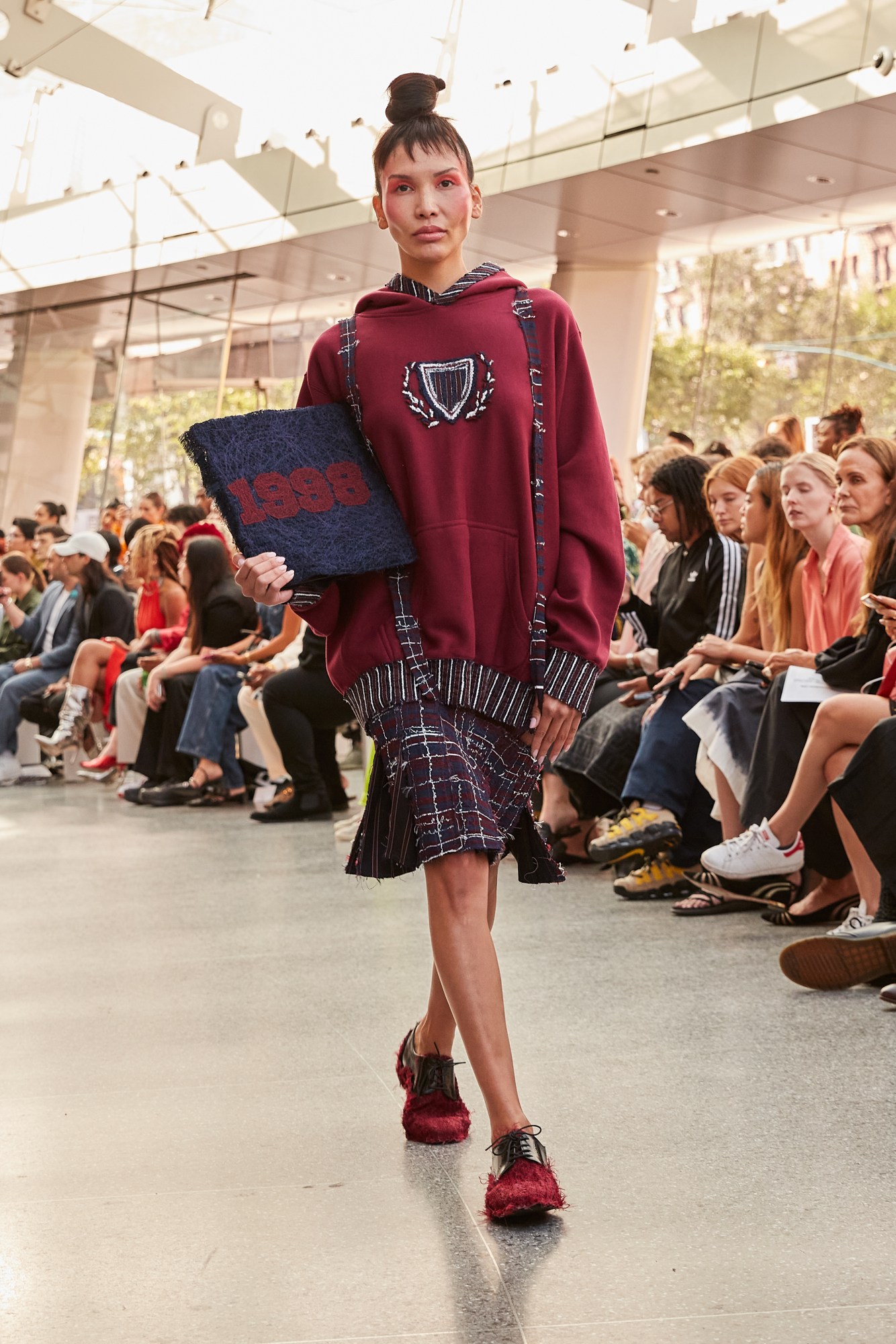
Ren Haixi
Where do you look for inspiration?
I am inspired by the relationship between dress code and identity.
What story, idea or concept was central to this collection?
I went to a private school in Beijing, where everything in my school was designed to imitate American prep school culture. I was always trying to find a balance between my artistic self, and the ideal prep school girl I was imitating.
What do you hope to communicate to your audience with it?
I hope my audience can relate to my interest in the performative aspect of life. I hope I can encourage my audiences to embrace their multiple sides and express themselves.
What is your first-ever fashion-related memory?
I grew up wearing uniforms, but I never gave up on finding ways to be different and “fashionable”. During middle school I started wearing extremely oversized hoodies and made everything low waisted.
What encourages you to keep going, especially in a fashion world that needs solutions?
I’m dedicated to solving the textile waste problem within the fashion industry. The deconstruction aspect of my textile allows me to create looks with minimal waste.
Where do you see yourself as a designer in the next five years?
I want to establish REN HAIXI into a successful brand in the next five years. I want to inspire more people to create desirable products using sustainable methods.
What modern designers inspire you today?
Jacquemus.
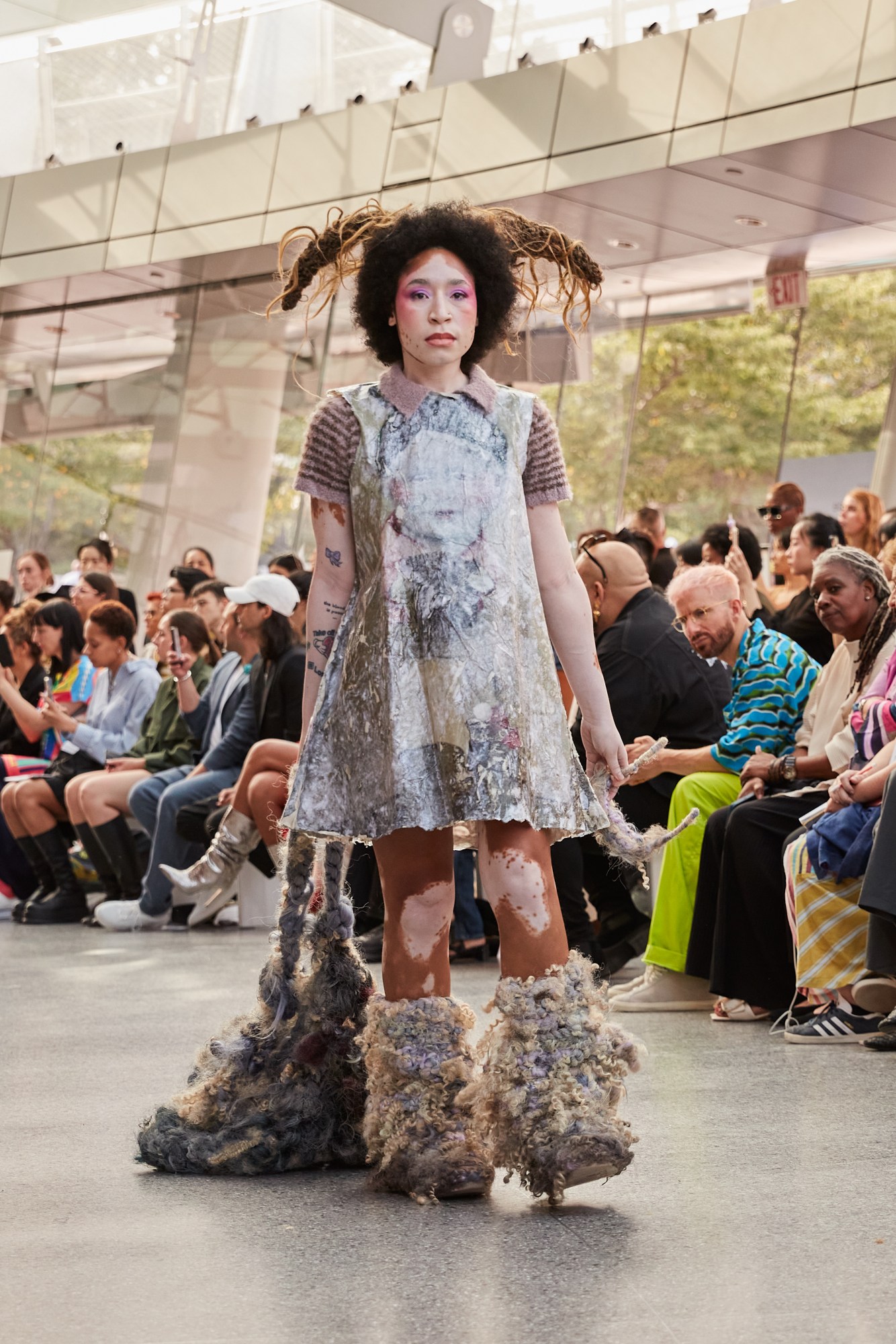
Lorena Pipenco
Where do you look for inspiration?
I always look to my family. If I ever feel uninspired, my family would tell me forgotten stories of their past.
What story, idea or concept was central to this collection?
Within this collection, I narrate their experiences of post-communist times and how it has played a big part in my identity as a designer. I visit the influences that these moments have created in the past and in the present, how those experiences affect each other. Romanian cinematography from the 70s stimulates these collections as a form of inspiration and nostalgia. There is a tension that is constantly altering how I feel, and conflicting my feelings — do I still love those things now that I know the true meanings?
What is your first-ever fashion-related memory?
As a single mother, my mom would work a lot and I would spend most of my time with my grandmother. When she had time to spare, she would draw these ladies all in a row with different dresses on them for me to color in. I was around 8 years old, and the thought of dresses always starts with this one, feeling the overwhelming feeling of happiness that I get to spend a moment with my mother.
What encourages you to keep going, especially in a fashion world that needs solutions?
Finding beauty in things that are uncomfortable. Knowing that there is still a form of happiness when creating.
Where do you see yourself as a designer in the next five years?
Continuing to try to find a balance between creativity and commerciality, hopefully selling my pieces in Dover Street Market — with an artist visa and living in New York.
Credits
Photography Aleksandr Karjaka. Courtesy of Parsons.
